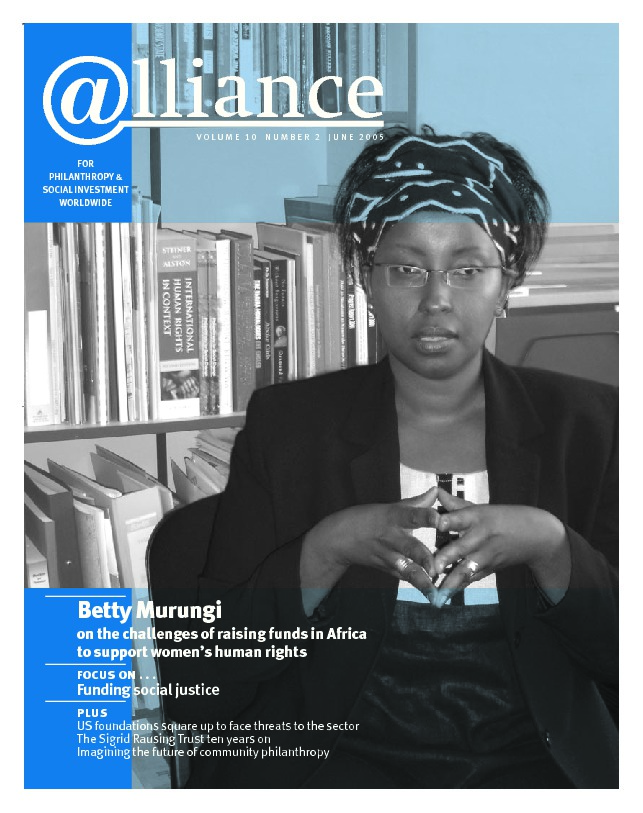I want to look at a technique for measuring social justice philanthropy, not attempt a definition of it. Nevertheless, I would like to set down two reference points: St Augustine’s ‘Justice is that virtue that gives everyone his due’ and John Rawls’ view of justice as consistency with that set of rules and conditions derived from ‘behind the veil of ignorance’, that is to say, from the perspective of not knowing what talents or station in life one may be born into.
Whether one looks to Augustine or Rawls or other philosophical traditions, there seems to be wide agreement that social justice is not to be understood as a final state or condition, but as something that derives from the relationships between individuals and institutions. In measuring social justice, therefore, we are measuring process more than content.
This view makes even more sense when we look at the mechanics of measuring change in complex social systems. Changes related to social justice characteristically take a long time to become visible – five years or more. They have many causal factors beyond the particular intervention of this or that funder or organization and it is notoriously difficult for any evaluation or measurement exercise to take account of all these factors.
This doesn’t mean there is no point in measuring, but that in order to measure effectively one needs to link measurement to a theory of change. The theory of change that makes sense to me goes something like this.
The purpose of measurement
The purpose of measuring is to increase understanding of what brings about social justice, and to do so in a way that increases the levels of action for social justice. Underlying the measuring process is the need to promote learning at individual, institutional and societal levels. It is also critical that the main agent of the social justice activities is genuinely accountable to those who have a stake in the activity being measured. Such a process would reflect what the Jewish moral philosopher Martin Buber terms the ‘I-Thou’ relationship at the heart of human morality.
The organization that I work with, Keystone (formerly ACCESS), is now building a model of learning and reporting based on these ideas for understanding, measuring and communicating justice-oriented social change. Keystone, and the tools that we are producing to support it, help organizations to:
- develop and communicate a plausible theory of change in which they identify clear social change objectives and practical steps to plan and measure them;
- understand the organizational capabilities required to achieve those outcomes;
- develop a strategy for engaging with and learning from those most affected by the organization.
The importance of stakeholder dialogue
The critical point here is that under the Keystone learning and reporting model outcome indicators are agreed with stakeholders and used to refine the theory of change, assess capabilities, and provide markers for stakeholder relationships. In other words, this approach grounds ‘metrics’ in stakeholder dialogue, and particularly those stakeholders most affected by the organization’s social change work. This approach seems to us to be most consistent with our understanding of how one uses measurement to further social justice methods (eg awareness raising, advocacy, social mobilization) and objectives.
The method, therefore, helps organizations build relationships of confidence, trust and support and respond effectively to stakeholder needs. It also helps them develop indicators for monitoring complex social change processes that are themselves responsive to those with most at stake. It develops organizational knowledge and thus helps them manage change and respond to opportunities. It can help win support and investment and, best of all, it encourages innovation in the solution of intractable problems.
Farewell to the ‘logframe’
Such a system appreciates failure when it leads to learning. And there is a further benefit worth mentioning. It offers an antidote to the logical framework planning tools so fashionable in the 1990s, and still being foisted on civil society organizations by some donors, particularly the large bureaucratic aid donors. Measurement understood as accountability for learning allows us to give the notorious ‘logframe’ a decent burial, and replace it with an approach that actually increases rigour in accountability, enables an appropriate degree of flexibility in planning and implementing social programmes, and fosters positive learning-based relationships between civil society organizations and their stakeholders (including their donors).[1]
1 For anyone retaining enthusiasm for the logframe, I highly recommend Alnoor Ebrahim’s brilliant analysis, ‘Information Struggles: The role of information in the reproduction of NGO-funder relationships’, in Nonprofit and Voluntary Sector Quarterly, vol 31, no 1, March 2002.
David Bonbright is CEO of Keystone. He can be contacted at david@accountability.org.uk
For more information about the Keystone learning and reporting system, visit http://www.accountability.org.uk





Comments (0)